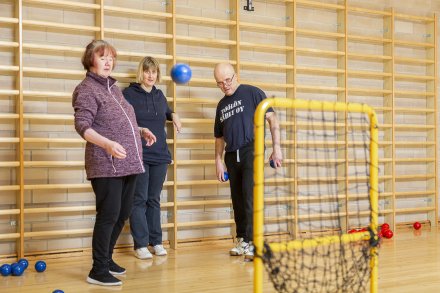What is Adapted Physical Activity?
Adapted Physical Activity (APA) refers to organized physical activity or activity promoting exercise for persons who, due to disability, illness or functional limitations, have difficulty participating in generally available physical activity. It includes physical activity services, rehabilitation-based movement, supported exercise programs and sometimes pathways toward para sport—depending on the individual’s personal goals and capacities. APA is built on inclusion, equal rights and participation for all.
Core Principles of APA in Finland
- APA is embedded in municipal services and NGOs. APA is coordinated nationally
- Delivered through intersectoral collaboration (health, sports, education, social services)
- APA supports autonomy, functionality, and social participation for persons with functional limitations
- The Finnish model is grounded in research, legislation, and long-term cooperation across sectors
A Brief History of APA in Finland
Finland has over 50 years of history in promoting adapted physical activity. Key milestones include:
1960s–1970s: Foundations
- The concept of adapted physical education was introduced in special schools and disability organizations.
- Early physical activity opportunities for people with disabilities were organized mainly by non-govermental organizaions (NGOs).
1980s: Municipal Integration
- 1984: The first municipal APA instructor roles were introduced in large cities.
- The aim was to provide inclusive, tailored activity services through public infrastructure.
- APA became gradually integrated into municipal sports and recreation departments.
1990s–2000s: National Expansion
- National networks and education programs for APA instructors expanded.
- University-level APA training was institutionalized, particularly at the University of Jyväskylä
- APA services began to cover a broader range of needs, including older adults and people with chronic illnesses.
2010s: Policy Alignment
- APA became more deeply embedded in national sport and health strategies.
- National steering groups were established, including the APA Workgroup (2016–) coordinated by the Finnish Society of Sport Sciences (FSSS).
- Local networks and projects were supported by state funding (e.g. Ministry of Education and Culture).
2020s: Terminology and Equity
- In 2021, a national terminology project was launched to modernize APA-related language. The final glossary was published in 2023, clarifying key terms such as adapted physical activity, functional limitation, impairment, para sport, and inclusive physical activity.
- APA is now supported by strategic recommendations for 2023–2026, with a focus on cross-sectoral services, inclusion, data, and standardized concepts.
Legal and Policy Framework
Adapted physical activity is not just a service — it is a legal right. The Finnish APA model is backed by robust national and international legislation:
National Legislation
The Sports Act (390/2015)
- "Everyone must have the opportunity to participate in physical activity regardless of age, residence, or functional capacity."
- Requires municipalities to promote equal opportunities to participate in sport and physical activity.
- Emphasizes non-discrimination and inclusive access in public services.
The Non-Discrimination Act (1325/2014)
- Prohibits discrimination based on disability or functional limitations.
- Requires public authorities (including municipalities) to actively promote equality in their services, including sport and exercise.
Act on Disability Services (675/2023)
- Replaces the previous Act on Services and Assistance for Persons with Disabilities (380/1987).
- Guarantees the right to individualized and necessary services for persons with disabilities.
- Recognizes physical activity and participation in recreational services as part of promoting independent living and inclusion.
International Commitments
UN Convention on the Rights of Persons with Disabilities (CRPD)
- Ratified by Finland in 2016.
- Article 30: Recognizes the right of persons with disabilities to participate in cultural life, recreation, leisure, and sport.
- Article 26: Requires the promotion of habilitation and rehabilitation, including through sport and physical activity.
WHO Global Action Plan on Physical Activity (2018–2030)
- Finland aligns APA efforts with WHO goals to reduce physical inactivity and ensure accessibility for vulnerable groups.
Summary
Adapted physical activity in Finland is the result of long-term, cross-sectoral work to improve the accessibility and inclusion of physical activity for people with disabilities, chronic illnesses, and functional limitations.
APA development has involved collaboration between municipalities, state actors, researchers, and non-governmental organizations over several decades. The work has been guided by legislation, evolving practices, and a growing understanding of equality and participation.
While implementation varies locally, many municipalities have integrated APA into their service structures and continue to develop inclusive solutions through research, training and national coordination.

Picture: Maarit Hohteri, city of Helsinki
